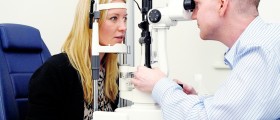
Glaucoma is an eye condition characterized by an increase in pressure inside the eyeball which, if not treated on time, may cause severe damage to the eye and even be blamed for loss of vision due to irreversible damage to the retina and the optic nerve.
Open Glaucoma Affects Many People
Open angle glaucoma is one form of the disease. As a matter of fact this is the most common type of glaucoma affecting around 70-80 % of people suffering from this debilitating eye condition. In the United States open angle glaucoma represents the leading cause of vision loss in adult individuals. The eye problem is especially troublesome because it can easily progress over years not causing any health issues but at the same time damaging structures inside the eye. Only people who undergo regular eye exams may be diagnosed on time, in early stages of the disease and with proper treatment they can avoid future complications.
Even though open angle glaucoma affects both eyes in most cases, it can also be unilateral, restricted to one eye only. It is predominantly diagnosed in older adults, people over the age of 50. The older the person is, the greater are the chances he/she will develop this type of glaucoma. Studies have confirmed that people of African origin are at higher risk of developing open angle glaucoma compared to Caucasians. What is more, if the disease has been reported in other family members, the person is highly likely to develop it him/herself. In fact, such individuals are 6 times likely to end up with open angle glaucoma that healthy people with no family history of the disease. And finally, the condition is more reported in patients who are already suffering from diabetes mellitus and cardiovascular diseases.
Medical experts believe that open angle glaucoma develops as a consequence of the aging process. Namely, as people get older the structures of the front portion of their eyes change in such a way that they become prone to blockage of aqueous flow. The drainage system of the eye is gradually becoming narrow and blockage occurs once the production of aqueous fluid is increased.
All in all, the disease is quite tricky because it may progress over the years not causing any problems but still being damaging to internal eye structures at the same time. This is the reason why older people should consider having their eyes checked on a regular basis.
How is Open Angle Glaucoma Diagnosed?
Standard eye examination includes specific tests which can reveal glaucoma, if the condition is present. The exam is performed by a few health care professionals including ophthalmologists, orthotists and opthometrists.
Testing begins with measuring the intraocular pressure. This is done through tonometry and gonioscopy (and exam that reveals the potential changes in anterior chamber of the eye). What is more, increased intraocular pressure may also precipitate changes in size or shape of the eye, both of which are noticed by a well experienced medical expert. Once the anterior portion of the eye is examined, doctors examine the posterior portion and pay special attention to the optic nerve, the one that can easily get damaged especially in patients with long-term disease. Optical coherence tomography, scanning laser polarimetry and scanning laser ophthalmoscopy are all performed in this purpose. It is also of major importance to take into consideration sex, race, history of drug use as well as inheritance and family history when examining certain patients.
As far as treatment is concerned, open angle glaucoma is practically incurable, but can be successfully managed and brought under control by lowering the pressure in the affected eye. The desirable effects are achieved with either eye drops or oral medications. Eye drops stimulate elimination of aqueous and medications may reduce its production. Many times patients need to take the prescribed drugs for the rest of their lives.
Unfortunately, medications may not be sufficient enough to control the pressure inside the eye. Such patients are then supposed to undergo surgery. The surgical approach has one goal, to increase the drainage of aqueous fluid and prevent its build-up in the front chamber of the eye. An argon laser trabeculoplasty allows desirable outflow of aqueous fluid. If it fails to decrease the pressure inside the eye, patients undergo trabeculotomy. Both procedures are highly successfully and when performed on time may easily prevent irreversible damage to the optic nerve.
To sum up, open angle glaucoma is a chronic eye disorder which easily triggers permanent damage to the optic nerve because it develops gradually, behaving cunningly and mischievously, causing no symptoms and signs. Many people have susceptibility to develop this form of glaucoma, especially older individuals, people of African origin as well as people already suffering from certain medical conditions. Family history plays significant role in the onset of the disease too. Still, with regular eye exams, the condition can be timely diagnosed and treated adequately.

















Your thoughts on this
Loading...